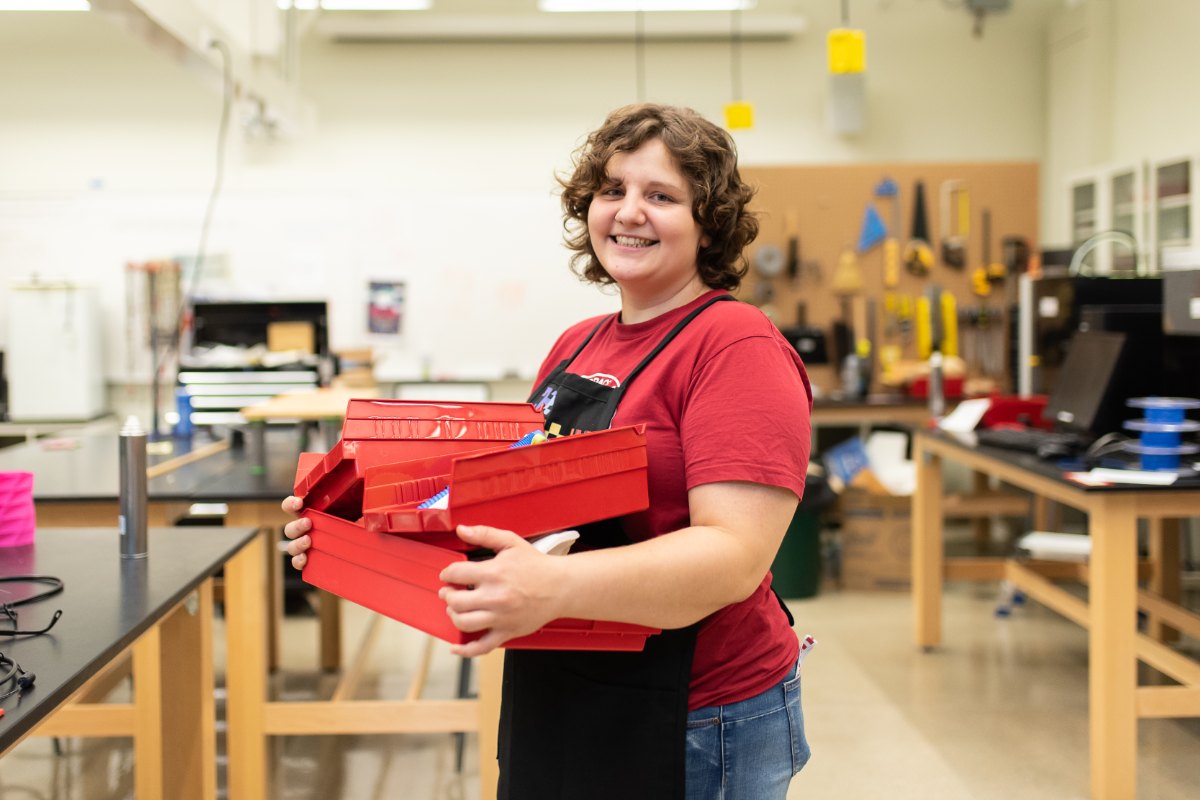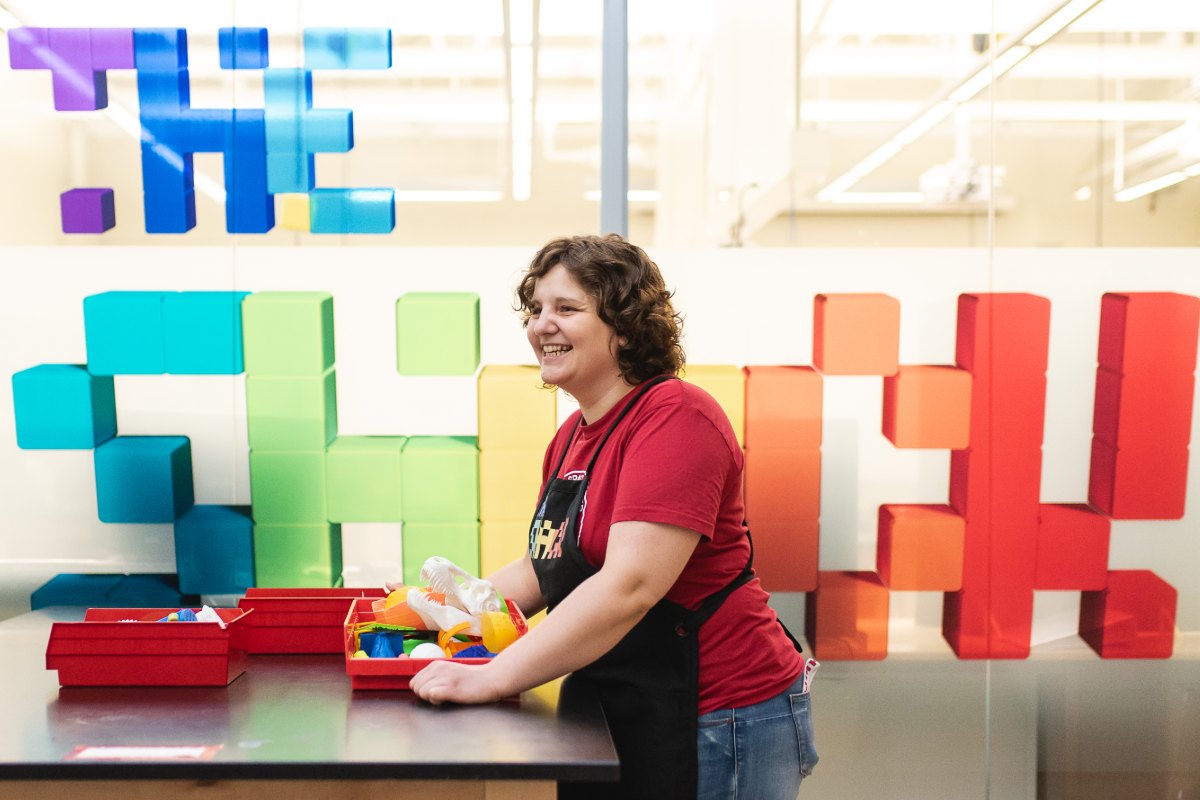
Danielle Jenson, pictured here in the Science Hardware Makerspace (SHACK), has used her backgrounds in both science and art to help other students harness their creativity in the SHACK. On June 11, she will receive a BSc in astrophysics. Photo credit: Dawn Graves
After a start in biochemistry wasn't the right fit, Danielle Jenson transferred to the Faculty of Arts and explored her creative potential, graduating with a BFA in sculpture. But for Jenson, a question lingered. She knew she had the potential to be a scientist-could she accept deciding not to pursue it? Four years of hard work later, Jenson will cross the stage on Tuesday with a BSc in astrophysics.
Sculpture and the stars might not seem like an intuitive combination, but like all student journeys on campus, there's a story behind this one.
"I grew up in a family where art was always a part of my life," said Jenson, whose great-grandmother was a local artist in the small town of Churchbridge, Saskatchewan. "When I first started postsecondary, I was fresh out of high school and had no idea about the sheer variety of opportunities that were out there. In the end, I picked biochemistry."
That, Jenson explained, turned out to not be the right choice for her. As she spent more time on campus and spoke with other students, however, she was inspired by the studio facilities in the Faculty of Arts and the creative potential there. She transferred to arts, where she completed her BFA in sculpture.
"When my first year in biochem didn't pan out, I began to think 'maybe I'm just not smart enough,'" said Jenson. "But during the last year of my arts degree, I began dating my boyfriend who was starting his graduate studies here in condensed matter physics. He was telling me about the experiment he was working on: what it did, how it worked. Not only was I interested, I realized I understood it."
Jenson explained that after working a year at a job that was not accessing all of her potential, she decided it was time for a change. She wanted to go back to school.
"I realized my lack of success in biochemistry had nothing to do with intelligence and everything to do with academic discipline," said Jenson. "I had to ask myself 'am I okay with knowing that I have the potential to be a scientist, but deciding not to pursue it?' The answer was no. I was driven to prove that I could."
The value of getting your hands dirty
With a firsthand experience of both arts and science education at UAlberta, Jenson explained that the greatest impact on her education has come from the instructors and faculty that advocate for what she sees as the university's best quality: hands-on work spaces.
One of those spaces is the Science Hardware Makerspace (SHACK), where Jenson has worked during the course of her undergraduate degree, helping students harness their own creativity to build innovative projects using electronics and 3D printers.
"The SHACK reminds me a bit of an art studio-there's a feeling there that you're able to create anything if you want to work hard enough," said Jenson. "There are many schools, in both arts and science, that are moving toward a less hands-on approach to projects and to a more online mentality. Facilities like the physics machine shop, the SHACK, the Student Innovation Centre, and every incredible art studio set UAlberta apart, and they're what have most helped me develop my skills."
A journey of many steps
As Jenson reflects on her years of schooling in both the Faculty of Science and the Faculty of Arts, she recalled some of the first steps on her path into the astrophysics program.
"It might sound like coming back to do a degree in science was an easy decision, but it was really more than that," said Jenson. "The first thing I had to do was reteach myself math. I had gone about seven years without doing any major math, and I could barely add or multiply in my head anymore."
To help prepare to return to the sciences, Jenson avoided using a calculator at her retail job, instead forcing herself to do the calculations in her head, and retaught herself high school math.
"After that, I tried out a semester of open studies, taking two first-year math courses. I remember I cried after my first midterm," said Jenson. "It wasn't the first time, nor the last, I'd been crushed by a test. But in the end, I got an A- in that course."
Jenson explained that she drew on resources from Accessibility Resources when she grappled with anxiety and ended up taking a reduced course load over the course of the program.
"I was able to get help and guidance through the accessibility centre, and it made a huge difference. I ended up with a 3.0 GPA in my final year, and it turns out I'm actually pretty proud of that," said Jenson. "I did it, I'm graduating, and I've made an impact-through the SHACK as well as other great extracurricular initiatives."
In being open about the adversity she encountered along the way, Jenson hopes to help share a message with other students just starting out on their own paths to success:
"Struggling through university happens. Just because you aren't breezing through doesn't mean you don't belong. Your persistence and your determination are the only things that decide that-it's up to you."
As for what comes next, for Jenson, she plans on upgrading a few important courses she feels she missed out on, then applying for graduate studies in condensed matter physics. She sees it as an extension of the perspective she's developed in both the arts and science:
"I want to harness that creativity in me, and I feel that will be best served in research. I'm following my own advice and I'm being persistent in reaching that goal."
